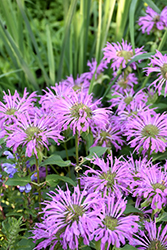It's all about ...
plants

Petite Wonder Beebalm
Monarda 'Petite Wonder'
Height: 18 inches
Spacing: 16 inches
Sunlight:
![]()
![]()
Hardiness Zone: 3a
Other Names: Bergamot, Oswego Tea
Ornamental Features
Petite Wonder Beebalm has masses of beautiful clusters of fragrant pink flowers at the ends of the stems from mid to late summer, which are most effective when planted in groupings. Its fragrant pointy leaves remain forest green in colour throughout the season.
Landscape Attributes
Petite Wonder Beebalm is a dense herbaceous perennial with a mounded form. Its medium texture blends into the garden, but can always be balanced by a couple of finer or coarser plants for an effective composition.
This plant will require occasional maintenance and upkeep, and should be cut back in late fall in preparation for winter. It is a good choice for attracting bees, butterflies and hummingbirds to your yard, but is not particularly attractive to deer who tend to leave it alone in favor of tastier treats. Gardeners should be aware of the following characteristic(s) that may warrant special consideration;
- Spreading
- Disease
- Self-Seeding
Petite Wonder Beebalm is recommended for the following landscape applications;
- Mass Planting
- Border Edging
- General Garden Use
Planting & Growing
Petite Wonder Beebalm will grow to be about 15 inches tall at maturity, with a spread of 18 inches. When grown in masses or used as a bedding plant, individual plants should be spaced approximately 16 inches apart. It grows at a fast rate, and under ideal conditions can be expected to live for approximately 5 years. As an herbaceous perennial, this plant will usually die back to the crown each winter, and will regrow from the base each spring. Be careful not to disturb the crown in late winter when it may not be readily seen!
This plant does best in full sun to partial shade. It is very adaptable to both dry and moist locations, and should do just fine under typical garden conditions. It is not particular as to soil type or pH. It is highly tolerant of urban pollution and will even thrive in inner city environments. This particular variety is an interspecific hybrid. It can be propagated by division; however, as a cultivated variety, be aware that it may be subject to certain restrictions or prohibitions on propagation.
